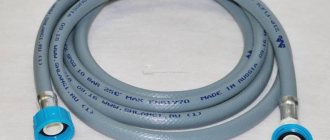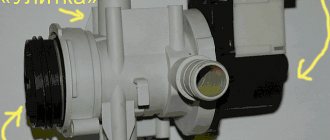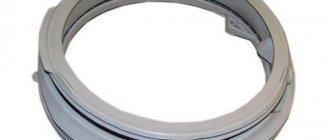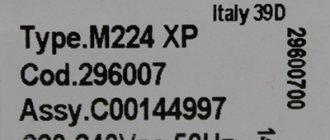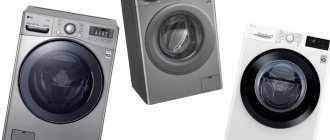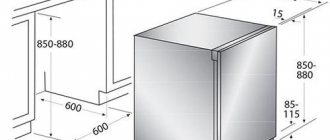Peculiarities
In 1956, the Nizhny Novgorod plant named after. Sverdlov began production of the legendary model. At the same time, the first copies appeared on the shelves. There was a line behind them. And soon the Oka brand proved to everyone that it has every right to exist. Soviet housewives really liked the unpretentious design and ease of operation. Previously, the plant named after. Sverdlov produced ammunition during the war, and then switched to producing civilian products. Since then, the company has been engaged in this area and has had good success.
Early Oka washing machines in the USSR were distinguished by their reliable design and impeccable performance. Even after they stopped producing the old models, they continued to work for a long time, since many housewives did not want to get rid of them.
The very first washing machines were not quiet. They were bulky and did not have a very attractive design. However, many were happy with this execution, especially those women who had previously washed by hand. Such a miracle of technology came to their aid. However, since the release of the first car, the design has remained virtually unchanged. Oka models continue to be produced in the form of a cylinder - this appearance is not fashionable and does not save living space.
The tank and the unit body itself form one whole. They are made of stainless steel or aluminum. The manufacturer continues to produce and offer for sale reliable models in blue and white-blue colors.
Today, Oka washing machines have the following varieties:
- centrifuges;
- semi-automatic;
- small cars
- activator type machines.
The latter do not have the usual drum. Instead, the manufacturer installs an activator in the lower part of the housing. It is connected to an electric motor. When the start occurs, the shaft begins to rotate and thereby twists the laundry. It is the activator type models that are considered excellent in terms of design due to the absence of a drum. Such devices break down less, especially since domestic units are still distinguished by their low price and excellent data. They can withstand temperature changes. Therefore, this type of machine is purchased for use in dachas.
Modern Oka units have their supporters and opponents. Proponents say that the design of washing machines is very simple. They are easy to use and inexpensive. Opponents of Oka models on various forums claim that the products are not assembled in an ideal manner. But still, most units work without interruption.
Moreover, there are still some models that were produced in the USSR. They have definitely undergone replacement of some parts, but they work. It is worth saying that to this day Oka cars are successfully repaired. Repairs are inexpensive. And if we talk about the washing process itself, the Oka machine can wash wool, cotton, knitted and synthetic fabrics.
History of the brand
The history of this brand dates back to 1956. It was then that the Oka washing machine appeared on the shelves of household appliance stores. The manufacturer was none other than the Nizhny Novgorod plant named after Ya. M. Sverdlov. Belonging to the military-industrial complex, the enterprise was engaged in the production of ammunition and explosives during the Civil War. Today, such products account for about 20% of the total volume of manufactured goods. Household chemicals, water heaters, and electric stoves produced by the plant are in consumer demand. Not least on this list is occupied by household appliances such as washing machines.
Recommendations
Since both the design and operating principle of this equipment are quite simple, you should not expect any special nuances in the operating instructions. Anyone can easily operate such models. This technique is likely to be especially convenient for older people.
Rotary switches located on the body will greatly simplify the tasks associated with organizing washing. However, between washing cycles it is better to give the equipment a chance to “rest”. Otherwise, intense load can lead to breakage of the plastic activator circle and even breakdown of the electric motor.
Source
Modifications
Over the years of production of the Oka model, many of its modifications were released. The car was produced with two main types of engines - 0.65 and 0.75 l, and depending on the installed power unit, it could have an index of 1111 (0.65 l) or 11113 (0.75 l). The factory designation of the model indicated the Volzhsky or Serpukhov Automobile Plant - VAZ or SeAZ, the cars were produced in various versions:
- for disabled people – SeAZ-1111-01/ SeAZ-1111-02/ SeAZ-1111-03 with a 0.65 l engine and SeAZ-11113-01/ SeAZ-11113-02/ SeAZ-11113-03 with a 0.75 l engine ;
- basic models - VAZ-1111 and VAZ-11113;
- a car with a 4-cylinder engine from Tavria - Astro-11301;
- model with a 1.0 liter engine in various modifications of SeAZ-11116, including pickups and vans.
VAZ 11113 Oka: technical specifications
The VAZ 11113 car is produced only in a hatchback body, in a three-door version, the car is designed for 4 people, including the driver. "Oka" has front-wheel drive, independent front and rear suspension, is equipped with a two-cylinder engine and 4-speed. manual transmission. The front suspension is standard for a car of this class, MacPherson type; a rigid beam with springs and shock absorbers is installed on the rear axle.
The brake system is hydraulic, with discs installed on the front axle and drums on the rear axle. Mechanical steering, hydraulic or electric power steering are not provided. The brakes have a vacuum booster and a master cylinder, a cable-type clutch without hydraulic release.
The engine of the VAZ-11113 model is two-cylinder, its location under the hood is transverse, some parts of the power unit are unified with the VAZ 21083 internal combustion engine (pistons, piston rings/pins). The cylinder block of the small engine is cast iron, the cylinder head is cast from aluminum. The timing drive is a belt drive, the camshaft is located at the top, in the bed of the cylinder head.
The VAZ 11113 “Oka” car has the following technical characteristics:
- dimensions (length/height/width) – 3.2 / 1.4 /1.42 m;
- wheelbase – 2.18 m;
- ground clearance – 15 cm;
- curb weight - 0.645 tons;
- maximum laden weight – 0.98 tons;
- wheel track (front/rear) – 1.21/1.2 m;
- ICE power – 35 hp. With.;
- ICE volume – 749 cm³;
- fuel system type - carburetor;
- fuel used - AI-92 gasoline;
- diameter of standard rims – R12
The Oka model with a 0.75 liter engine consumes 5 liters of gasoline fuel per 100 km on the highway; in urban mode, fuel consumption increases to 7.4 liters/100 km. The gasoline tank is designed for 30 liters, and on average the volume of the gas tank is enough for 400-450 km of travel. The VAZ-11113 does not accelerate quickly - in 24 seconds, but it is fast enough for city limits. But the Oka has an advantage in the city - the car is very maneuverable and can easily be parked anywhere.
Activator type machines
Oka washing machines of the activator type are distinguished by the fact that a disk with blades is built inside the flat bottom. It's called an activator. It is driven by a motor. An activator washing machine washes clothes approximately 70%.
The Oka-16 model is an activator type machine. This is a free-standing vertical loading machine. The maximum amount of laundry that can be loaded into it at a time is 2 kg.
The activator washing machine is controlled mechanically. The knob installed on the panel is turned and the washing time is set. The timer is set to 4 minutes. When the washing time is finished, the machine turns off. If you need to turn off the machine earlier, this can be done. The tank is made of stainless steel.
The blades, under the influence of the engine, begin to rotate, the water, and with it the laundry, too. As a result, the dirt is washed off mechanically. Then the water with the powder flows back into the tank through the hose.
When you need to drain the water, remove the hose from the holder and install it in the drain.
The machine does not have modern functions, there is no drying and no leakage protection. The car is white. Weight - 16 kg.
The Oka-18 model can wash 3 kg of laundry at a time. Machine weight 16 kg. The tank is made of stainless steel.
The Oka-10 model is similar in principle to the previous one. It turns on mechanically using a timer. A hose holder is installed near the lid. Tank volume 32 liters. Weight - 13 kg. The machine can wash 2 kg of laundry.
The Oka-9M washing machine has a blue body. The height of the device is 98 cm, width - 80 cm. Weight - 22 kg.
The Oka-19 model is installed separately. Laundry is loaded from the top. It is placed in a 3 kg stainless steel tank. There is no drying, but there is a manual squeezing device. The body of the machine is made of steel and covered with durable enamel.
We connect the motor from an old washing machine
With the development of household appliances, modern automatic washing machines very quickly settled in apartments and houses and became good helpers for modern housewives. Old washing machines were moved to garages and storage rooms because they were no longer needed. If you still have the engine from an old Soviet washing machine, then you can put it to good use. Make it into a sharpening machine and you can sharpen knives, axes and other cutting tools.
After rummaging a little in my closet, I found a working AEP-16UHL4 engine from an old Soviet washing machine; it had been removed from the washing machine and was quietly collecting dust on a shelf littered with all sorts of rubbish. Once upon a time I wanted to make a sharpener from it, so on the motor shaft there is an adapter sleeve for an emery wheel turned by a familiar turner. Now I will tell you how to connect it.
To start the engine, a special three-contact relay RTK-1-3UHL4 is used.
Before connecting anything, you need to ring the windings with a multimeter. The motor has two windings, “starting” and “running”. The starting winding resistance is 26 ohms. The resistance of the working winding is 13 ohms, that is, half the resistance of the starting winding. In short, the winding with low resistance is “Working”, and the winding with high resistance is “Starting”.
This figure shows a diagram of connecting the AEP-16UHL4 motor from a washing machine. To make the motor rotate in the other direction, you need to swap the leads of the starting winding.
In the end, I got a sharpener from an engine from an old washing machine. I hope everything works out for you too.
Friends, I wish you good luck and good mood! See you in new articles!
I recommend watching a video on how to connect a motor from an old washing machine.
Repair of washing machine "Oka-7" SMR-1.5
| Dry laundry load, kg | 1,5 | Activator drive power, W | 180 |
| Washing tank capacity, l | 28 | Activator rotation speed, rpm | 760 |
| Washability, % | 62 | Number of washing programs | 1 |
| Residual humidity, % | 97,2 | Noise level, dB | 62 |
| Washing time, min | 6 | Dimensions (LxDxH), mm | 515x820x965 |
| Motor type | AER-16 | Weight, kg | 26 |
Washing machine device.
The Oka-7 washing machine is designed for washing and rinsing clothes at home. The body is cylindrical in shape, made of carbon steel and equipped with rollers for moving in different directions, as well as a bracket to ensure stability when spinning clothes.
There are plastic handles for carrying the machine. The washing tank is made of aluminum alloy AMTSM and installed in the machine body. The activator is located on the inclined bottom of the tank and when its blade disk rotates, liquid flows are created, with the help of which the laundry is washed and rinsed. Depending on the selected washing mode, the paddle disk can rotate in two directions:
Rice. 1 Design of the Oka-7 washing machine .
The fluid indicator is located on the inside of the tank. The rotation of the activator disk is carried out by an electric motor through a V-belt drive. An electric motor is installed on the inclined frame, the position of which can be adjusted using special longitudinal grooves, thereby adjusting the tension of the V-belt.
The connecting cord with plug enters the housing through an opening. In the non-working position, the cord is wound around a bracket, which is welded to the machine body.
In the upper part of the body, a squeezing device with two rubber-coated squeezing rollers is secured to brackets with screws. The rollers are pressed using a flat spring, and the pressing force can be adjusted using a screw. A removable handle is inserted into the hole of the lower roller axis, through which the rollers rotate. The top of the tank is closed with a removable lid, which is also used to receive wrung out laundry.
In case of overloads and overheating of the electric motor, the machine is switched off by a starting protection device. The washing machine is turned on by turning the time relay knob. After the set washing time has elapsed, the machine switches off automatically. The washing mode is set by turning the washing mode switch knob with the time relay turned off. When the machine is operating in normal mode, contacts 3 and P, 2 and P are closed. In gentle mode, contacts 1 and P, 2 and P are closed.
The squeezing device consists of manual squeezing rolls. The surface of the rollers is covered with an elastic (rubber) layer. The rollers are driven by a handle that is inserted into the hole in the lower roller. The pressing force of the rolls is adjusted by a screw located on top of the squeezing device. Before washing, the squeezing device is installed in the upper part of the body on brackets and secured with locking screws. When not in use, the squeezing device is removed and stored inside the washing tub.
The main unified components of the Oka-7 washing machine are: a squeezing device, an activator unit, an electric drive, a drain hose, a machine cover, a laundry grip, and running rollers.
About mechanical malfunctions of the washing machine, such as extraneous noise, jamming, etc. read mechanical faults of washing machines. See also typical malfunctions of non-automatic washing machines and their elimination.
Electrical equipment.
Rice. 2 Electrical circuit diagram of the Oka-7 washing machine.
For self-repair about electrical faults of Oka-7, read faults in the electrical circuit of washing machines
Used “Skorobogatov N.A. Modern washing machines and detergents 2001”
All the best, write
to Elremont 2006
Design and types of Oka cars
The first Oka models were bulky and noisy, and their appearance, to put it mildly, left much to be desired. The situation was saved only by the absence of goods from foreign manufacturers in domestic stores. Today, the manufacturer offers a more diverse range of activator washing machines . Nevertheless, the design has not undergone any special modifications. So, most models still have the same cylindrical body shape, traditionally corresponding to a small-sized tank. For buyers who have a rational approach to organizing their living space, this characteristic of Oka will be among the negative. There is no variety of colors. The models are presented in only a few options - blue and white-blue.
Over the past years, Oka washing machines of the following varieties have rolled off the production line of the enterprise:
- small cars;
- activator type machines;
- centrifuge machines;
- semi-automatic devices.
Engine
Another reason when a washing machine is electrocuted may be the motor. It is a device consisting of steel, aluminum and copper. The windings are insulated with varnish and placed in special insulating trays made of special cardboard or fiberglass.
The motor heats up during operation. In this case, the temperature can reach critical values and lead to melting of the varnish. As the insulation between turns deteriorates, the resistance changes downward, which leads to more current consumption and the release of additional heat. As a result, a breakdown often occurs on the motor housing, and then on the washing machine housing.
Checking the washing machine motor
Repair is carried out as follows:
- It is necessary to get to the inside of the washing machine, for which the back wall of the case is removed.
- The motor is located under the drum casing, at the bottom. The connector with contacts is on the side, on the left. It is necessary to remove it and at the same time clean it from possible contamination.
- Next, you need to check the motor using a multimeter. The technology consists of measuring the resistance of both windings and the housing. Accordingly, the readings of the device when testing the housing and between different windings should tend to infinity at the highest limit.
- If there is resistance, then it is necessary to remove the motor and wash and clean it, if necessary. If the resistance is not infinite, then the motor requires repair.
FakeHeader
Comments 20
Ours as always! The better the idea, the further it goes on the shelf. It’s impossible to count how many projects have been buried.
They were simply late with the carburetor engine, and that’s why they installed a Chinese injector.
What? What are you talking about? The Chinese injector was installed only in the last years of production.
There’s no need to be so indignant, I’m talking about a three-cylinder engine, and you? At least they installed Chinese, but this one didn’t, that’s what I wrote.
Then how should I understand you? We were late with the carburetor, so we installed an injector. Where were you late?
They were late with the carburetor engine, since they did not meet environmental standards. They had to install an injector, which the Chinese already had, Euro 2 and immediately Euro 3. If this engine is transferred to an injector, they will be late again, since the standards are becoming stricter.
That's it. If you don't know, don't say. It's nonsense. This engine was originally developed for the production of Oka. Only then came the resolution to produce the engine cheaper, so they made half a nine at VAZ.
Where does this information come from, about this engine and about the resolution? If that's the case, then I really don't know.
Read the history of the car on the Internet. It also says about this engine.
The Internet is not an authority for me; you can write whatever you want. Facts and only facts.
How can I provide you with the facts? After all, all the facts are on the Internet, you stupid little sparrow.
Stupid is the one who stoops to insults when there is nothing to say. It’s a pity for such people.
That's it. If you don't know, don't say. It's nonsense. This engine was originally developed for the production of Oka. Only then came the resolution to produce the engine cheaper, so they made half a nine at VAZ.
If you watched the video carefully, you would have noticed that the gearbox is Okovsky, and the motor is through the plate. Did they first invent the bulldozer box, and then invent a motor through a plate to it? You're talking nonsense. The engine marking is 1121, and this is nothing more than Oka-2, which was developed in the middle of 2000, and they tried different engines, but they were too late. If you don't know, don't say.
The Oka was created as a people's car, designed to satisfy the demand not only of young people, but also to fill the existing niche of transport and mobility vehicles for people with disabilities.
Based on the technical requirements and the assignment put forward to the designers, the entire car, and in particular the power unit, had to be made from widely used components and be able to carry out maintenance and repairs with one’s own hands without involving the qualified services of a certified service station.
The history of the development of the Oka family of cars has seen the use of various power units. Initially, during “prototyping” the original Daihatsu Cuore AB series engine was installed on the car, which had 2 cylinders and developed a power of 26-30 hp. The first few vehicles were produced for testing.
Despite the fact that the engine design was completely worked out by Toyota designers, this engine was not copied by Soviet designers, since the analysis of the design revealed increased requirements for the quality of parts and assembly of the engine itself.
In addition, the installation of such a power unit would require a complete production of engines from “0”, which would affect the final cost of the car and the timing of the car’s production.
By 1979, VAZ power unit designers had fully developed the 2108 engine and were ready to move on to changing the line of 1.1 liter export VAZ 2108-1 engines to the 1300 cc 2108 engine, which was going to the domestic market. Therefore, it was decided to develop its own 2-cylinder engine based on a new power unit, which formed the basis of VAZ’s production line.
Activator
These units are distinguished by the presence of a flat bottom, into which a disk with blades is mounted. This is the activator, driven by the engine of the machine. Reviews from housewives claim that OKA activator washes things by 60-70%. What models belong to this type? OKA-16 is a prominent representative of activator-type machines. According to the instructions, the drum is designed for 2 kg of laundry. OKA-16 is controlled using a mechanical rotary knob.
OKA-9
This is a washing unit for home use, equipped with a manual spin device. The OKA 9 washing machine, which we see in the photo, is suitable for washing clothes made from different fabrics. External parts and the cover of the device are made of steel, the tank is aluminum. The external parts are painted with blue enamel, which makes this model remarkable. OKA-9 is an activator-type unit that allows you to wash things at home with any detergent.
OKA-9
OKA 8
Like the previous model, this unit is made in blue. OKA8 is an activator type device designed for 2 kg of laundry. According to the classification of washing and drying quality, this model belongs to C and B classes. Compared to automatic cars, these indicators cannot be called good. But despite this, many people buy Oku 8 and Oku 7 due to their low cost.
OKA 8
OKA 18
Another representative of the activator-type machines is the OKA 18 model. The device is designed for 3 kg of laundry. Among the advantages, it should be noted the affordable cost and unpretentiousness in choosing a detergent. Otherwise, such a unit will not replace a modern automatic machine. OKA 18 is not characterized by high quality washing, it is noisy, although it does not fail for 20-25 years. As practice shows, the OKA 18 washing machine is an excellent option for unpretentious pensioners who do not have large funds.
OKA 18
Oka 19
This model of activator washing machine was released in 2012. Traditional vertical loading, small capacity and economical consumption of water and electricity made this model popular among the poor. The tank of the OKA 19 device is made of stainless steel, the body is enameled. And although the OKA 19 washing machine is equipped with a manual control mechanism, it is still popular among buyers due to its reliability and long service life.
OKA 19
OKA 50
Washing machine OKA 50. Shown in the photo, it is small in size. This is an excellent option for a summer house where it is not possible to install a full-size machine. But despite the fact that the height of the unit is only 50 cm, it holds 2.5 kg of laundry. The tank, made of composite plastic, holds 30 liters of water.
OKA 50
The compact model is equipped with the following useful functions, which are mentioned in the instructions:
- Possibility of half loading.
- Selecting the appropriate temperature for washing.
- Start the timer.
The manufacturer provides a 2-year warranty for the device. But practice shows that OKA 50 M operates without problems for 5 to 10 years.
OKA 50
Interview of washing machines
December 28, 2022 +1
LG: 2022 is the year of speed and sensitivity to each other
What was 2022 like for LG? What brand equipment has become popular among Russians this difficult year? What interesting new products await us in 2022? Mr. YoungNam Roh, President of LG Electronics in Russia and the CIS countries, spoke about everything without concealment. Click to find out all the details!
December 8, 2022 +3
Candy: 2022 is a good year for sales
Have you ever bought equipment after listening to the seller’s advice? Are you disappointed? Candy equipment is sold in a different way
How, read in the interview with Gleb Mishin, the company’s general director. He also talked about the most important question of 2022, which took on new meaning, and gave advice on when to make purchases. Open, read, interesting
December 1, 2022 +2
Bosch: 2022 is the year of new refrigerators and washing machines
In 2022, Bosch launched a new range of narrow washing machines and refrigerators. What else this year will be remembered for the company, what difficulties the company faced, the General Director of BSH Russia, Hubert de Haan, told us. All the details are inside.
July 28, 2020
Covid and the household appliances market: who wins
Expectations among manufacturers and sellers of household appliances were quite mixed due to the coronavirus, but the result of the first half of the year was not so bad. Ruslan Voloshkin, director of business development in the regions of Russia and the CIS at Askoli Kitchen Systems LLC, summed up the results of the first half of 2022.
October 30, 2022 +2
LG: about trends, specifics and forecasts for the future
At the headquarters of LG Electronics in Seoul, Natalya Smirnova spoke with the head of the international sales and marketing division for kitchen appliances, business unit of household appliances and climate systems of LG, Mr. Young Nam Ro. He spoke about new products in LG household appliances, which models are in demand in Russia, and what will be popular in the near future.
Activator washing machines
The main feature of activator-type washing machines is the absence of the usual drum.
This type of design gets its name from the plastic circle with blades installed in the lower part of the body - the activator. An electric motor is installed at the very bottom of the unit. When the equipment is started, the shaft or circle begins to rotate, thereby mixing the laundry. It is no secret that some experts consider the absence of a drum to be a serious advantage of the models. The simplicity of the design means that such equipment will require repairs less often. It is not surprising that some summer residents still successfully use the Oka, which was produced during the Soviet Union. Having set a goal, you can even find units that, over the years of operation, only needed to replace some spare parts . This task is not a difficult one - service stations can be found in every region of Russia.
Main signs indicating the need for repairs
- Does not turn on (problems in electronics or connection).
- Does not start (thermostat, start-protection relay, compressor).
- High temperature in the chambers (the door is open for a long time, freon leakage, the evaporator is not freezing, defective door sealing elements).
- Starts and stops (protective or starting relay, electronics, wiring).
- Water under the appliance (clogged drain, overflowing tray, defective drain tube).
- It is noisy (the No Frost system is working, the engine suspension is faulty, the capillary tubes are not secured).
The list of faults has a much larger number of items. If you have any problems, contact a professional.
Washing machine tests
May 31, 2021
solo test
Dryer Candy RapidO RO4 H7A1TCEX-07
When I started testing the Candy RapidO RO4 H7A1TCEX-07 drying machine, I expected that I would be able to dry blankets, bed linen, and remove wrinkled semi-dry shirts and other linen from the machine ready for ironing. And most importantly, I will get rid of the drying system, which occupies the entire balcony. Did you manage to achieve the desired result? First things first.
March 25, 2021
solo test
Candy Smart Pro CO34105TB1/2-07: narrow washing machine with wide capabilities
The narrow washing machine Candy Smart Pro CO34105TB1/2-07 with a depth of 34 cm and a load of 5 kg is one of the most inexpensive washing machines in the Candy range. But at the same time, it has remote control, 9 quick programs for different types of fabrics, and the ability to add additional washing modes through the application. Want to know more?
December 29, 2022 +1
solo test
Washing machine CANDY Rapid'O: checking all the possibilities
The CANDY Rapid'O RO441286DWMC4-07 washing machine with the hOn application can not only wash clothes (all washing machines can do this). This device promises to create perfect cycles for different clothes. And if you don’t know which mode to choose, then she will suggest a program by looking at a photo of dirty clothes and reading the care label. This is the first part of the test, in which we talk about the quality of washing and all the functions.
November 11, 2014 +3
solo test
Hansa WHS 1261 DJ washing machine test: minimum buttons, maximum washing
It's no secret that the main helper around the house is the washing machine, because washing has always consumed a lot of time, which could be devoted to people dear to you or more interesting activities. Now that the “washing machine” has firmly established itself in every home, I want it not only to cope well with dirty laundry, but also to be “smart,” beautiful, convenient and understandable, so as not to look at the instructions before each wash.
October 5, 2013 +9
solo test
Test of the Atlant SMA 70C1010 washing machine: I wash everything
Atlant washing machines are well known to housewives. The brand's lineup is constantly updated with new products. One of them is in front of you, and we tested it. SMA 70С1010 is part of the new SMART|action series. And this is advanced functionality and, as the name suggests, a smart, effective approach. The machine combines an impressive set of programs, more advanced control, design innovations and care for people.
Small washing machines
Machine "Oka-50M" with a vertical loading type. Differs from conventional activator models in shape. It is made in the form of a rectangular parallelepiped with rounded corners. A hose holder is installed near the lid.
The maximum amount of laundry that can be loaded at one time is 2 kilograms. The tank is plastic. Its volume is 30 l. There is no drying or protection against leaks.
Emery from a washing machine motor
An emery machine is useful for almost any household.
It can be made in a simple way - to do this, it is enough to prepare the motor from an automatic washing machine in working condition. When you attach the sharpening stone to the motor, some difficulties may arise - the hole of the stone may not coincide with the diameter of the electric motor shaft.
In this case, you need to take an additional part that will need to be specially machined. This adapter can be easily made by any turner; you just need to tell him the diameter of the shaft.
In addition to the adapter, you need to have a special bolt, nut, and washer.
The thread on the nut should be cut depending on which direction the motor will rotate.
In order for the motor to rotate clockwise, the thread must be left-handed; for counterclockwise rotation, the thread must be right-handed.
If you do the opposite, the stone will constantly unwind and fly off during work.
It may be that you have a nut, but the thread direction is not correct. Then we change the direction of rotation. In this case, we swap the winding wires.
We connect the working winding to a 200 V network, connect the starting pair to the working coil.
We apply the second end to the winding terminal for a short time. The commutator electric motor will begin to move in one direction.
When the locations of the starting winding terminals change, the direction of movement of the motor will change to the opposite.
The direction of rotation of the motor can be changed without using a capacitor. Here, after connecting the working winding to 220 V, we sharply turn the stone in the right direction.
After this, the motor starts and the machine starts working.
The lineup
- A plastic tank with a volume of 30 liters is a distinctive characteristic of the Oka-9 model. The “drying” function is not provided, as well as protection against leaks. In one cycle you can wash no more than two kilograms of laundry.
- But “Oka-18” is capable of handling as much as three kilograms per wash. Moreover, the tank of the machine is made of stainless steel, and its weight is 16 kg.
- The Oka-10 model, which weighs 13 kg, is similar in principle of operation. There is a timer on the case. The hose holder is located near the cover. The tank volume is 32 liters, which allows you to wash 2 kg of laundry.
- The tank housings of the small-sized Oka-50 and Oka-60 are made of plastic. If the first model is designed to wash two and a half kilograms of clothes, then you cannot load more than one kilogram into the second. Both models are not suitable for intensive use. The main disadvantage of these machines is their weak power. However, they are quite suitable for baby clothes, as well as personal items.
- Knitwear can be washed and rinsed perfectly by the Oka-8 activator machine. In addition, you can wash clothes made from cotton, wool and synthetic fabrics in it. Distinctive external features of this model are an aluminum tank and an enamel-coated body.
- The cylindrical body of the Oka-7 model is made of carbon steel. This equipment will be convenient to move around your apartment or house. And all thanks to the running rollers. The presence of a special bracket guarantees stability when spinning clothes. This model has several washing modes. Depending on what exactly you want to wash, you need to choose the direction of rotation of the paddle wheel. The ability to rotate the paddle disk counterclockwise during normal operation ensures high-quality washing of items made from dense fabrics. During the "gentle" mode, the paddle disk rotates clockwise. This is a universal option for washing clothes made from regular fabrics and low-density fabrics.
- The Oka-11 washing machine is one of the models with mechanical control. The material for the manufacture of the case was stainless steel. During vertical loading, the maximum weight of loaded laundry is 2.5 kg.
Maintenance of Oka engines
The Oka engine of both the first and second generations is quite reliable. And if the factory requirements for maintenance regulations are met, it has a service life of 120,000 km.
According to the vehicle passport, both engine 11113 and engine 1111 have a maintenance program every 15,000 km. To undergo maintenance at this interval, it is recommended to use fully synthetic motor oil. When using semi-synthetics, and even more so mineral motor oils, the Oka engine requires changing the lubricant in accordance with the service life of the oil, that is, at least 10,000 km.
In this case, the oil system must be flushed and the filter element replaced. The oil volume in the Oka engine is 2.5 liters, but when replaced, 150-300 ml of lubricant remains on the engine walls, so the filling volume is controlled by the dipstick. Overfilling of oil is not allowed.
The OKA 11113 engine cooling system requires fluid replacement after operating 60,000 km. At the same time, the coolant retains its lubricating and anti-corrosion properties and prolongs the operation of the cooling system.
Additional work that is not relevant on modern cars includes mandatory cleaning of the carburetor every 30,000 km with idle adjustment at each regular maintenance.
At 60,000 km, regardless of the technical condition, the timing belt is replaced. The design of the cylinder-piston group allows the valves to bend when the belt breaks, so this procedure should not be neglected.
Opinions about the Oka car
There are many conflicting opinions about the VAZ-11113 car - this car has many positive qualities, but the reputation of the vehicle is greatly spoiled by poor build quality and a high percentage of defective parts. Among the positive aspects, car owners note:
- excellent maneuverability - the car can be easily parked almost anywhere, in city traffic it is quite easy to change from one lane to another;
- surprisingly roomy trunk - with the rear seats folded down, a lot of things fit into it;
- good cross-country ability - thanks to the narrow wheel track, small size and light weight, the Oka does not get stuck in snowdrifts and confidently climbs out of shallow mud;
- low fuel consumption.
There are also a lot of disadvantages in a VAZ car:
the suspension does not cope well with Russian rough roads - it is quite flimsy, the miniature R12 rims bend even from a small impact; the car does not have high anti-corrosion resistance; bodies and body parts rust especially quickly on cars produced after 1995; Okushka's security is low; You need to drive a car through water carefully - the ignition coil stops working if it gets wet, and in rainy weather the spark plugs become damp; the quality of spare parts is low, especially if they are non-original parts; The original mirrors are small and inconvenient - almost nothing is visible in them.
To summarize, we can say that the VAZ-11113 is a very good car, but it requires constant care, and it was created for people with “hands”. If you do not monitor the technical condition of the car, the Oka will quickly “crumble”.
The prototype of “Oka” was the small “Mishka” and “Kama”. They, in turn, were born from Fiat-126 purchased in 1979 in Poland. At the design bureau of UGK KamAZ, the Italian trucks were dismantled, the engine was moved forward, raised higher, a fiberglass body was made and sent for testing. In 1986, a resolution of the USSR Council of Ministers was issued, which stated that it was necessary to create capacities for the production of small-class passenger cars at KamAZ. Designers from VAZ joined the group of Chelny designers. They jointly carried out layout work and also developed design documentation for the front and rear suspension, brakes, and steering.
Making the Oka a full-fledged “people's car” turned out to be a utopia. And everything is clear: the main purpose of a personal passenger car in our country, as is known, is associated with transporting the family on weekends to their summer cottage and removing agricultural products from there. The small machine was not able to provide this functionality. And going to work alone is also not the luckiest idea, because you could always use public transport, which ran quite normally, and the cost of tickets was a pittance. “Oka” was also not suitable as the main remedy against city traffic jams - there simply weren’t any in those days.
The familiar small Oka car was designed at the Volzhsky Automobile Plant at the end of the 20th century. It was assumed that this model would become widely popular, but it did not work out. And again news from VAZ engineers - a new Oka has been created, the price of which is quite affordable. At the beginning of the year, the company's president announced the revival of the project to create this car.
Oka washing machines: greetings from the past
Oka washing machines: greetings from the pastIn Soviet times, a domestic housewife did not have much choice: either you buy a washing machine made in the USSR and put up with all its shortcomings, or you continue to wash by hand. The first washing machines in our country began to be produced in the mid-1950s, and they were often produced at military-industrial complex enterprises. These were heavy, noisy units, the attractive design of which no one cared about - fortunately, buyers had no choice anyway. So it is not surprising that when the “Iron Curtain” finally rusted and crumbled into dust, and products from foreign enterprises poured onto the shelves of Russian stores, domestic washing machines were not in demand.
But a number of brands still managed to survive. In particular, this applies to Oka washing machines, the production of which is carried out at the plant named after. Y. M. Sverdlova. By the way, this enterprise is still directly related to the military-industrial complex. Created back in 1916, the Nizhny Novgorod Explosives Plant supplied the Red Army with ammunition and explosives during the Civil War, and also played a significant role during the Great Patriotic War. But in the 1950s, a decision was made to turn the economy a little towards people and at least try to saturate the market with household appliances. It was then, in 1956, that Oka washing machines were born.
Exhibition stand of the plant named after. Sverdlov: washing machines - and not only
These days, the plant named after. Ya. M. Sverdlova continues to produce explosives and ammunition, but their share in the total production volume is about 20%. The plant's product range includes household chemicals, water heaters, and consumer goods. And washing machines, of course.
Design
At the first glance at the Oka washing machine, you get the impression that the “Iron Curtain” is still in place, and the Soviet Union had no intention of disintegrating. The cases of most models are cylindrical. This is due to the fact that in small-sized washing machines the body, in fact, is the tank, and this was done, in particular, for the purpose of economy. But this does not look very attractive and is not entirely convenient from the point of view of rational use of space.
This is what Oka might look like after a few years of use
If the white and blue coloring of most models looks more or less normal, then the blue color used to paint the bodies of some Oka units evokes associations with a hospital.
In general, they clearly saved as much as they could on the appearance.
Design Features
Oka units are activator-type washing machines. This means that they do not have the usual drum. The body simultaneously functions as a tank, that is, washing occurs directly in it. A plastic circle or shaft with protrusions is installed in the lower part, which is called an activator. The electric motor is also installed near the bottom. When the machine is turned on, the circle or shaft rotates, mixing the laundry.
"Oka" inside and out
Although most modern washing machines are equipped with a drum, activator-type devices have their supporters. The main advantage of this type of washing machine is that its design is very simple. This means that they rarely fail (fewer parts mean less chance of failure) and are also cheaper. In fact, it is for these reasons that Oka cars continue to enjoy comparative popularity. On forums on the Internet you can read a lot of negative reviews that the assembly of Oka units leaves much to be desired, but nevertheless, even in this condition they can work for a very long time, so that their service life will significantly exceed the time specified in the warranty card. In principle, in our country it is quite possible even now to find “Oka”, which was released back in Soviet times and is still working.
Some cars are equipped with a device that some will clearly find archaic. We are talking about rollers for spinning clothes, fixed in such a way that water flows back into the tank of the washing machine.
Main characteristics
Since Oka washing machines are of the activator type, then, as mentioned above, their tank and body are practically the same thing. The lower part of the body is usually made of steel, and for the upper part, the tank-body, in which the washing directly takes place, stainless steel or aluminum alloy is used. A steel case will be heavier, but stronger, an aluminum case will be lighter, but more susceptible to mechanical damage. Lids are made of plastic or aluminum.
This is what Oka washing machines look like when they come off the assembly line
Loading, accordingly, is vertical. The tank volume, depending on the specific model, ranges from 32 to 40 liters. One of the characteristic features of Oka washing machines is their compactness, but you have to pay for the reduction in size by the fact that not so much laundry can be washed at a time. One of the largest models, Oka-14, has dimensions of 493x481x768 mm. At the same time, it will fit no more than 3 kg of things. The load of most models is even less - 2-2.5 kg.
Oka washing machines are controlled mechanically using classic rotary switches. Basically it all comes down to turning on the machine and then waiting for it to finish washing. The manufacturer does not recommend performing several washing cycles in a row, as this can lead to rapid wear. Most often, the plastic activator circle is the first to fail; due to intense load, it simply breaks. Then the electric motor may not be able to withstand it. So, after washing clothes, it is better to take a break until the next load - at least half an hour to an hour.
Assembly of washing machines at the plant named after. Sverdlova
In Oka machines you can wash cotton, wool, synthetic and knitted fabrics.
Small-sized washing machines "Oka"
The Oka model range includes several small-sized cars. “Oka,” as already mentioned, is already considered a compact washing machine, and small-sized models can be called ultra-compact. These are peculiar heirs of the famous Soviet “Baby”, which women living in small apartments dreamed of. For example, “Oka-60M” has dimensions of 350x370x455 mm, so it can be put away, for example, in a closet or pantry, and taken out when the need arises. In principle, such small-sized devices could be used as built-in equipment, but there is one “but”: these models have vertical loading. If someone with golden hands can solve this problem, then the small-sized Oka can be safely built in somewhere.
Small-sized "Oka-50" and "Oka-60"
The tank-cases of the Oka-50 and Oka-60 models, classified as small-sized, are made of plastic. This makes them extremely light (especially the Oku-60, which weighs only slightly more than 5 kg), but with a strong impact the tank can crack. The manufacturer claims, however, that high-strength plastic is used to make the cases, which cannot be taken with any blow.
“Oka-60” is designed to load 1 kg of laundry, but “Oka-50” can load 2.5 kg at a time. But do not forget that these models are not designed for intensive use. If there is a need to wash several batches of laundry, you will have to take breaks between washes, otherwise you may be left without a machine.
Another problem is the rather low power. For example, it is unlikely that you will be able to wash a set of bed linen in the small Oka: the engine is simply not able to turn the sheet and duvet cover. So it is optimal to use these models for washing clothes of newborns, small children, underwear, etc.
Summary
In many respects, the Oka washing machine looks like a kind of hello from the past. It is not equipped with many pleasant and useful functions that would make its operation easier and improve the quality of washing clothes. There is no talk of any washing programs; control comes down to a simple “turn on - off”. In appearance, “Oka” also looks, if not an outright anachronism, then something approaching it. It is characterized by a fairly high consumption of water and detergents, which is due to the specifics of activator-type washing machines - there must always be a liquid medium inside during operation. Its design does not include a pump, so the owner has to fill the tank with water using a hose. When the machine is turned on, it makes a very loud noise. There is no protection against water leaks in its design.
Taking into account the above, a reasonable question arises: why do buyers buy Oka in the first place? And in the regularly held competition “One Hundred Best Products of Russia”, some models of this brand sometimes took prizes - but for what? After all, at first glance, these are household appliances, entirely consisting of shortcomings.
Obviously, the point is low price and compactness, as well as efficiency and unpretentiousness. With the average price for most models varying between two and four thousand rubles, Oka can be bought cheaper, somewhere around 1200-1500 rubles. Thanks to its small size, it can be used in small apartments. It does not require connection to a central water supply, which means that such a washing machine can be safely used in a village or at a summer cottage.
"Oka" is well suited for use in a village or suburban area
Again, “Oka” is quite suitable for older people who do not strive for the highest quality of washing and at the same time are not always able to cope with the complex control system of a modern washing machine. Here everything is simple: put the laundry in, pour in water, add washing powder, close the lid, flip the toggle switch - and then all you have to do is wait for the wash to finish.
Another advantage of Oka is its wide network of service centers. You can repair a washing machine of this brand in almost any region of Russia, and abroad, in countries such as Ukraine, Belarus and Kazakhstan, there are many certified workshops.
So Oka washing machines can really be perceived as “hello from the past.” But as long as the echoes of this past continue to exist, the existence of washing machines of this brand is completely justified.
Washing machine news
June 1, 2021
Market news
Farewell IFA 2021
IFA 2022 was planned for early September in Berlin. But the organizers made a difficult decision: the IFA will not take place this year. Eh, we will miss her.
May 31, 2022 +1
Company news
Hisense laser TVs work in DNS
You can now see how the Hisense laser TV works in DNS stores throughout Russia, where special brand zones are equipped. I wonder if they will broadcast EURO 2022 football matches there, which will start very soon? If so, then brand zones in the DNS will become very visited.
May 14, 2021
Company news
Hisense is donating tickets to the 2020 European Football Championship
The 2022 European Football Championship will take place this summer. Want to go to the matches? Does Hisense give away and even give away tickets? Terms and conditions inside. Click and participate!
May 14, 2021
Company news
Hisense is the official sponsor of the 2022 FIFA World Cup
The 2022 FIFA World Cup will be held in Qatar from November 21 to December 18. It’s unusual that it’s not in the summer. But watching the broadcast on large Hisense TVs will not be hot. The company again became the official sponsor of the football competition.
May 12, 2021
Market news

